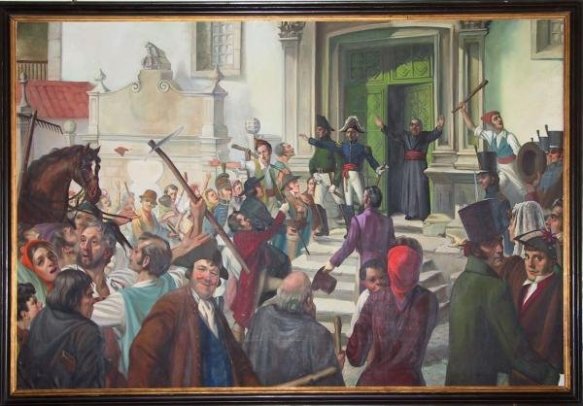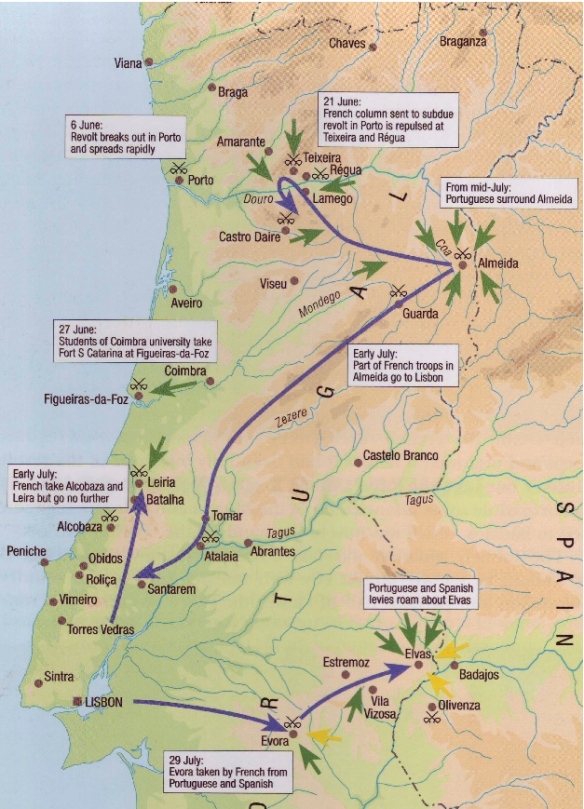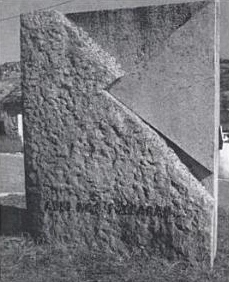The small Battle of Teixeira June 1808 came about from the Portuguese uprising against the French and Spanish 1807 joint occupation. General Junot had marched across Spain, and with some Spanish assistance, occupied the larger towns of Portugal and Lisbon. The Spanish troops were uneasy with the situation however, acting as they effectively were under French orders and senior commanders. Not so the French, who saw superb opportunities for self-enrichment with this latest addition to Napoleon’s empire. Apart from seizing and pocketing of public and private property and the large levy of 100MM French francs for France, the union with Napoleonic Europe was proving an economic disaster for this small international trading nation.
At this point that an event took place in Madrid (May 2, 1808) that changed European history. After Napoleon’s attempt to seize control of Bourbon Spain, the Dos de Mayo rising led the rapidly spreading revolt in Spain to wash over Portugal. The occupying Spanish armies refused French orders to tamper down the young Portuguese revolt, or even joined them in some cases. In the northern or the southern territories of Portugal, only the French army could spread out to control the fortresses, the ports and greater Lisbon, the economic center of Portugal.
Thousands were joining the rising in the northern provinces of Portugal. Flocking to the national colors held under Colonel (soon general) Silveira and General Gomes de Sepulveda, the city of Porto soon joined the cause under the Bishop of Porto. A Supreme Junta was set up on June 19th to govern the country in the name of the exiled Prince Regent Joao VI. The French needed to suppress town revolts, even disarmed some Spanish formations during early June, but slowly only the major towns and fortresses were the in-country demarcation of French control. As long as they held Lisbon, the strategic fortresses (border and seacoast), and some ability to send out columns to pacify the countryside (collect crops, levies etc), they could whether the revolt till additional French corps arrived from France. It was one of those French columns which attempted to march on the revolt central hub at Porto which led to the battle of Teixeira, a defeat for a small portion of the undefeated Le Grand Armee and a full month before the disaster at Baylen and the sailed British intervention in Portugal under Lord Wellesley.
While General Junot had his hands full with Lisbon and communications to now revolting Spain via Evora and Elvas, he ordered GD Loison at Almeida fortress to send a strong column toward Porto. On June 17th, GD Loison dispatched several infantry battalion, a battery and a small dragoon squadron (1800 men by French sources, 2600 by Portuguese) to march on Porto, across the revolting northern provinces . Reaching the Douro river at Regua (now called Peso da Regua) on June 21, he forded the Douro river, and by marching west along the northern bank, arrived at the small village of Teixeira, a populous rural area with steep hills and mountains whose sides were covered with vineyards. Thousands of hostile pike armed Portuguese swarmed the overlooking hillsides, shadowing his movement. GD Loison nevertheless marched forward, passing Mesao Frio and towards Amarante. He never made it, for ahead, on a steep hillside ahead, a deployed force of Portuguese militia and some ex-portuguese army soldiers (4500), commanded by General Fransisco de Silveira, was barring his path.

Portuguese Ordenanza pikeman common for the early 1808 campaign. Muskets were rare, except for former Portuguese army soldiers, till the English sent military arms later in 1809.
General Silveira positioned his forces in echelon and around the heights which dominated Teixeira from three sides. The question was: would his untried, badly armed and ill-disciplined men be able to stand the French bayonet charges? The French certainly did not think so. If they attacked the Portuguese centre in front of them, they were confident of carrying it and reasoned the whole Portuguese force would panic and flee. GD Loison’s legere infantry advanced, some Portuguese, mostly badly armed peasants, were scattered. As the French climbed and increasing lost their impetus, they found more Portuguese, many of whom had firearms as well as pikes. Even two small cannon served by recruited gunners joined General Silveira’s makeshift force. Sharp hillside action, GD Loison received a slight wound, and some of his soldiers were killed or wounded. The French retired to regroup, as more Ordenanza appeared. The French rear train was attacked and it’s escort almost overwhelmed back in Regua. The French retired further to defend their column train at Regua. Next day (June 22nd), as General Silveira realized his force couldn’t defeat the positioned French in Regua, GD Loison wisely decided to recross the Douro river southwards and march back to Almeida. Pursued by Portuguese, the French lost most of their baggage, plunder, 300 casualties and two howitzers before reaching Almeida on July 1st.
WR’s scenario design, including set up, terrain, weather, forces involved, and victory conditions can be read on these scenario notes (.doc): Teixeira 1808 Scenario notes
Rosters for French and Portuguese on one spreadsheet: Teixeira 1808 scenario rosters (.xls). Found under the “Army command” worksheet.
This scenario is a classic “large but untried” militia rabble with a few seasoned units vs. a small elite force of proven veterans. In many ways this scenario is like the Lexington – Concord running fight (1775) except the Portuguese don’t have as many firearms. Both sides have different play styles. The French can win almost any stand up fight but have exposed flanks and limited forces. The Portuguese outnumber the French in miniatures at start and grow larger as time passes. The key is Morale Fatigue points (MFP) management. The Portuguese are brittle, too many flee the tabletop will cause the entire Portuguese command or force to dissolve before the French bayonets. If the French cannot cause severe Portuguese routing, they will grow stronger and overwhelm the French defense when the French exceed their MFP and start declining their CMR values every hour turn. If the French lose too many soldiers early on in the battle, the cumulative effect quickens the MFP threshold and declining CMR morale.
Brief Morale Fatigue Point overview: Morale Fatigue Points (MFP)
Many of our scenario game aspects and rules can be found at this link: Napoleonic Rules, files and videos.
Since the Portuguese won…. they erected a monument.
Sources: Apart from supportive web material, the sole source WR had for this scenario was Osprey’s Vimeiro 1808 book. The front sections of this book give reasonable coverage of the Portuguese revolt before the arrival of the English army under Lord Wellesley and is worth the reading. If another source is available, WR would like to know.
Cheers from the warren,
WR








Well documented, as always…thanks!
Phil.
Thanks Phil,
Interest action which only the reading of the Vimiero 1808 book did I think about a possible scenario.
Still trying to catch that “bald headed” national guardsman. He held your line in the last AAR at Paris 1814
M aka WR
Very interesting, I’ve not heard of this battle before.
Ray,
Yep, It was a surprise for me too. When I read the Vimiero 1808 book I just saw a scenario like the Lexington-Concord 1775 action pop into my brain. Then when I noticed the date was before the French disaster at Baylen did I realize this was one of the first “checks” on the French army in the Peninsular. Gave it extra “flavor”. Now to playtest the resulting scenario with a “live gamer”.
Micahel aka wR
Very good written information. It will be helpful to anyone who utilizes it, including myself. Keep up the good work – i will definitely read more posts.
An interesting Peninsular twist, with the Portuguese in action before their restructuring under British guidance.
Our area has a high ethnic Portuguese (and now, as a secondary result, Brazilian as well) population; originally the Portuguese immigrated to the area in the later 1800’s to work in the then famous hat industries of Danbury, CT. At that time, Mercury was widely used in the processing of the pelts used to make the hats; absorption of mercury through the skin caused heavy metal poisoning in many of those workers, with resultant psychiatric symptoms. This was the origin of the phrase “Mad as a Hatter”, as well as “The Mad Hatter” character in Lewis Carroll’s “Alice in Wonderland”.
I have several patients with the first name of Joao (John in Portuguese); saw one today, in fact!
Peter
Peter,
That was my first impression…. a Portuguese victory before the known Spanish and English victories of 1808. And the likeness to a Lexington-Corcord running action too. I should check the WR’s hat…. with those long ears pointing out… maybe I have gone silly with these off-brand scenarios. A quick (normal) Quarte Bras 1815 game should be the fix. Interesting side story on the Mad Hatter tale. My father (UCLA School of Medicine) did a major international study on the effects of mercury poisoning, and the human brain back in 70-80’s.
Michael aka WR (w/hat)
P.S.
Loved your Piave 1809 AAR too. My re-played Sacile is scheduled for the 16th.